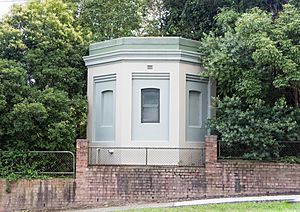Pymble Reservoirs No. 1 and No. 2 facts for kids
Quick facts for kids Pymble Reservoirs No. 1 and No. 2 |
|
|---|---|

Pymble Reservoir No. 1 valve house
|
|
| Location | Pacific Highway, Pymble, Ku-ring-gai Council, New South Wales, Australia |
| Built | 1900 |
| Built for | Metropolitan Board of Water Supply and Sewerage |
| Owner | Sydney Water |
Official name:
|
|
| Type | State heritage (built) |
| Designated | 15 November 2002 |
| Reference no. |
|
| Type | Water Supply Reservoir/ Dam |
| Category | Utilities - Water |
| Lua error in Module:Location_map at line 420: attempt to index field 'wikibase' (a nil value). | |
The Pymble Reservoirs No. 1 and No. 2 are two old water storage tanks in Pymble, a suburb of Sydney, Australia. They are located on the Pacific Highway. These reservoirs are special because they are listed on the New South Wales State Heritage Register. This means they are important historical sites.
The reservoirs are owned by Sydney Water. This is a company that provides water services in Sydney. They were added to the heritage list in 2002.
Contents
Why Were Pymble Reservoirs Built?
Supplying Water to Sydney's Northern Suburbs
A long time ago, in 1888, the company in charge of Sydney's water supply was called the Board of Water Supply and Sewerage. Back then, water only reached the northern suburbs through a pipe under the harbour. This pipe carried water from Paddington Reservoir. However, Paddington Reservoir was not high enough to supply water to all the higher areas of the northern suburbs.
To fix this, a pumping station was built in North Sydney in 1888. It had two large storage tanks. These tanks helped get water to the higher parts of North Sydney. Later, in 1892, this system was taken down. The pump was moved to Carlton, and the tanks went to Wahroonga.
New Water Systems for Growing Areas
In 1892, the Ryde Pumping Station started working. It got water from Potts Hill through pipes. This water then went to reservoirs at Ryde and then to two reservoirs in Chatswood.
As more people moved to the North Shore, especially because of the new railway, more water storage was needed. The tanks that were once in North Sydney were moved to Wahroonga in 1896. A new pumping station was built in Chatswood in 1895 to send water to Wahroonga. A new steel reservoir was built in Wahroonga in 1898. From Wahroonga, pipes stretched to Hornsby and other areas like Thornleigh and Beecroft.
Both Pymble Reservoir No. 1 and Pymble Reservoir No. 2 were built in 1900. Their purpose was to help supply water to the local Pymble area.
What Do the Pymble Reservoirs Look Like?
Pymble Reservoir No. 1: A Circular Brick Structure
Pymble Reservoir No. 1 is a round reservoir made of brick. It has a roof over it. In the middle of the roof, there's an eight-sided brick building. This building has a cone-shaped roof made of tiles. The reservoir also has special metal caps on its roof for ventilation.
Next to this reservoir, there's another eight-sided building called a valve house. It's made of brick and has a flat roof. Inside, there's a metal floor and a ladder to reach the water valves below.
The area around this reservoir has plants like oleander. Today, the Pymble Bowling Club clubhouse is on this site.
Pymble Reservoir No. 1 can hold about 2.3 million litres of water. Its full water level is 173 metres high.
Pymble Reservoir No. 2: A Concrete Bowling Green
Pymble Reservoir No. 2 is a great example of a concrete reservoir that is covered. It's partly dug into the ground. The roof of this reservoir is covered with grass. It is now used as a bowling green by the Pymble Bowling Club.
The only parts of the reservoir you can see from the bowling greens are two ventilation shafts. They look like old metal gateposts. It's common for covered reservoirs to have their roofs used for fun activities or open spaces.
On the south side of this reservoir, there are three valve houses. One is large and in the middle, with two smaller ones on either side. These buildings are made of brick and have flat roofs. They are built into the side of the reservoir's grassy bank. All the valve houses still have their original valves and control equipment. The main valve house has space for six valves.
Pymble Reservoir No. 2 can hold a lot more water, about 31 million litres. Its full water level is also 173 metres high.
Changes Over Time
Some changes have been made to the reservoirs. For example, pool-style fences were added in the late 1900s for safety.
Why Are These Reservoirs Important?
The Pymble Reservoirs No. 1 and No. 2 are important because they show how water storage technology changed over time. They are part of a small group of covered reservoirs, and each one is a bit different. This helps us understand how these structures were built in New South Wales.
The valve houses at Pymble are special because they still have their original valve control gear. This is very rare to find in the Sydney Water system.
These reservoirs also show how much water was needed as the population grew in the suburbs. They demonstrate the high level of engineering skill available when they were built. They are important examples of how water supply systems developed in New South Wales.

